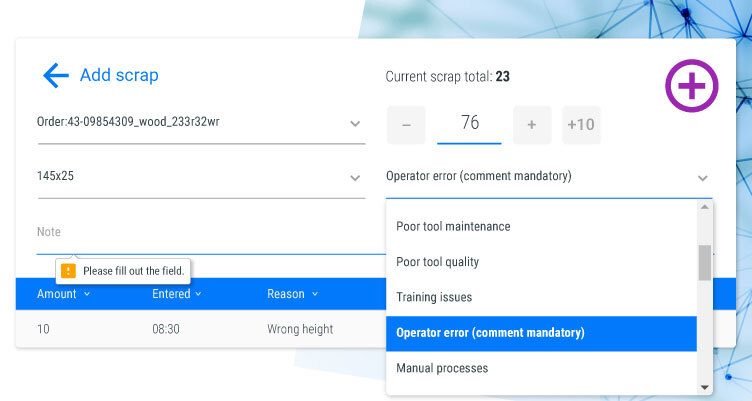Cost Of Quality In Manufacturing
What is the Cost of Quality (COQ) in manufacturing? Do you even measure your quality? Why do you measure quality? How do you measure it? What do you do with collected quality data? These are questions that production managers and quality managers face every day!
Cost of Quality (COQ) in Manufacturing is a methodology for quantifying every euro a factory expends to ensure products meet specifications—or to deal with them when they don’t. It breaks down into:
Prevention costs, such as investment in machine calibration, operator training, preventive maintenance programmes and process design improvements that stop defects before they arise.
Appraisal costs, including in-line inspections, end-of-line testing, quality audits and the labour required to measure and record conformance.
Failure costs, split into
Internal failures (scrap, rework, unplanned downtime and disposal of defective material), and
External failures (warranty repairs, customer returns, field service visits and lost sales due to poor reputation).
By measuring COQ on the shop floor, manufacturers can pinpoint exactly where money is leaking—whether it’s from excessive scrap rates on a given machine, repeated setup errors by an inexperienced shift team, or costly returns from end users. Armed with this data, production planners and quality engineers can compare the cost of installing an additional sensor or scheduling a weekly maintenance window against the savings from fewer breakdowns and less rework—ensuring every improvement delivers a clear return on investment.
Do You Measure Your Quality?
Measuring quality is no longer an optional extra—it’s a fundamental pillar of any manufacturing operation aiming for world-class performance. With GlobalReader’s OEE solution in place, every part produced is immediately assessed against your quality criteria: dimensions, tolerances, surface finish or electrical integrity, for example. Sensors, machine-integrated gauges and operator feedback all feed into a single digital record, so you know exactly how many parts pass inspection and how many don’t, in real time.
Beyond simply counting good versus bad, quality measurement in MES context also captures the nuances of each defect—what type it is, on which machine it occurred and under which operating conditions. This rich data set replaces manual inspection logs and removes any guesswork from your quality metrics.
Why Do You Measure Quality?
Measuring quality isn’t just about hit-and-miss counts; it’s about protecting your bottom line and reputation. A defect rate of 1.6 % might sound small, but as our Cost of Quality example shows, it can translate into nearly 2 % extra production cost—and that erodes margins fast. By tracking quality precisely, you can identify which lines, shifts or raw-material batches are driving scrap and rework, then target improvements where they matter most.
On a broader scale, a clear quality metric is crucial for continuous improvement. As you drill down into defect causes, you reduce variation, optimise processes and build a culture of excellence. Customers notice too: fewer defects mean fewer returns and complaints, strengthening your brand’s reliability and opening doors to higher-value contracts.
How Do You Even Measure It?
In a modern MES environment, like GlobalReader software is, quality measurement happens automatically at every production step. Vision systems inspect parts on the fly, operator prompts guide manual checks, and smart sensors record any deviation from tolerances. All events—pass, rework, scrap—are timestamped and tagged with contextual data (machine, operator, material lot), feeding straight into your OEE dashboard.
For operations without vision systems, tablet or touch-screen prompts let operators log quality checks in seconds, eliminating paper and transcription errors. Meanwhile, integration with SPC (Statistical Process Control) tools allows you to chart defect trends, control limits and capability indices without leaving your MES.
What to Do with Collected Quality Data?
Collected quality data is only as valuable as the actions it drives. First, set up live alerts: when scrap rates exceed your threshold, notify maintenance or process owners so they can intervene before waste escalates. Second, feed defect origins into your production planner—if a machine is trending toward higher rework, allocate extra capacity elsewhere or schedule preventive maintenance during the next downtime window.
Next, leverage root-cause analytics: drill from a summary scrap-rate chart down to the individual downtime codes or material batches that underlie defects. Use this insight to refine setup procedures, retrain operators or optimise tool change-over sequences. Finally, track the impact of each corrective action in your OEE and quality dashboards to ensure continuous gains and close the improvement loop.
Cost Of Poor Quality
Let's look at an example what is the COQ of one product. Let's assume production company is producing product, where:
Labor Costs 10 €
Raw material 10 €
Consumable ( water, electricity, heat etc.) 2 €
Various manufacturing costs 3 €
TOTAL: 25€
Monthly production amounts to 40 000 pcs.
Product Quality is 98,4% Therefore 39360 pcs are good and 640 pcs are scrap. Monthly order amount was also 40 000 pcs, that means 3 things: Orders did not get ready - a delay for the clients.
Production had to produce additional 640 pcs+ 11 pcs (640*98,4%) of product. Scrap had to be recycled what costs additional 5€ /pcs.
To summarise, the expected production cost when Quality is 100% is 40000*25 €= 1 000 000 €. Actual production cost when Quality is 98,4% is (40000+640+11)*25+(640+11)*5= 1 019530 € = 19530 € (1,95%) more than expected for the whole project.
So for the 98,4 % of products one product production cost is 25€ But for the 1,6% of products one product production cost is ( Total cost of production- Good product cost of production ) / bad product amount ( 1 019 530 €-984000 ) /640 = 94,93 €. Almost 4 times more than it was supposed to be.



